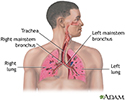Parapneumonic pleural effusion
Pleural effusion - pneumonia
Pleural effusion is a buildup of fluid in the pleural space. The pleural space is the area between the layers of the tissue lining the lung and the chest cavity.
In a person with parapneumonic pleural effusion, the fluid buildup is caused by pneumonia.
Causes
Pneumonia, most commonly from bacteria, causes parapneumonic pleural effusion.
Symptoms
Symptoms can include any of the following:
- Chest pain, usually a sharp pain that is worse with cough or deep breaths
- Cough with sputum
- Fever
- Rapid breathing
- Shortness of breath
Exams and Tests
Your health care provider will examine you and ask about your symptoms. Your provider will also listen to your lungs with a stethoscope and tap (percuss) your chest and upper back.
The following tests may help to confirm a diagnosis:
- Complete blood count (CBC)
- Chest CT scan
- Chest x-ray
- Thoracentesis (a sample of fluid is removed with a needle inserted between the ribs)
- Ultrasound of the chest and heart
Treatment
Antibiotics are prescribed to treat the pneumonia.
If the person has shortness of breath, thoracentesis might be used to drain the fluid. If better drainage of the fluid is needed due to more severe infection, a drain tube can be inserted.
Outlook (Prognosis)
This condition improves when the pneumonia improves.
Possible Complications
Complications may include:
- Lung damage
- Infection that turns into an abscess, called an empyema, which will need to be drained with a chest tube
- Collapsed lung (pneumothorax) after thoracentesis
- Scarring of the pleural space (lining of the lung)
When to Contact a Medical Professional
Contact your provider if you have symptoms of pleural effusion.
Contact your provider or go to the emergency room if shortness of breath or difficulty breathing occurs right after thoracentesis.
References
Blok BK. Thoracentesis. In: Roberts JR, Custalow CB, Thomsen TW, eds. Roberts and Hedges' Clinical Procedures in Emergency Medicine and Acute Care. 7th ed. Philadelphia, PA: Elsevier; 2019:chap 9.
Broaddus VC, Light RW. Pleural effusion. In: Broaddus VC, Ernst JD, King TE, et al, eds. Murray and Nadel's Textbook of Respiratory Medicine. 7th ed. Philadelphia, PA: Elsevier; 2022:chap 108.
Reed JC. Pleural effusions. In: Reed JC, ed. Chest Radiology: Patterns and Differential Diagnoses. 7th ed. Philadelphia, PA: Elsevier; 2018:chap 4.
Review Date: 8/19/2024









